Learn how to make the easiest homemade sourdough bread recipe perfect for beginners. All you need is a few ingredients, some time, and patience. You’ll never want to go back to store-bought bread again.
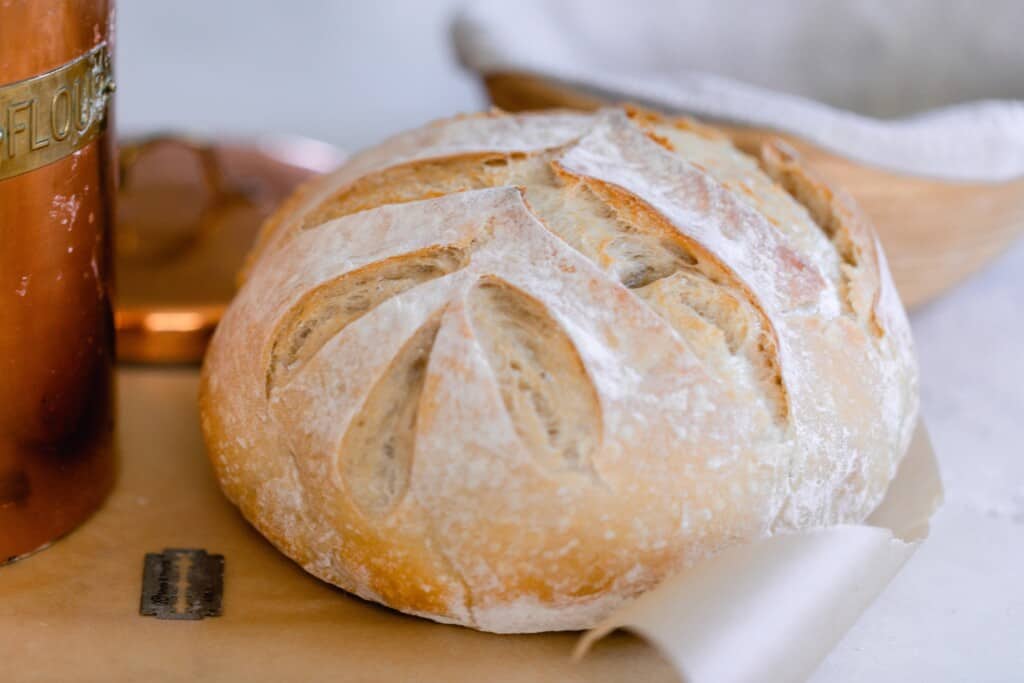
Table of Contents
I remember when I first started out on my sourdough journey. It was about 12 years ago, around the time of when my second daughter was born.
That first loaf of sourdough bread was not pretty, or really that edible to be honest. But I was proud I created something out of my own two hands from just a few ingredients.
Over the years I’ve really honed in on my sourdough baking skills and now have hundreds of recipes on this blog to show you just how simple it can be.
So today I’m going to show you step-by-step how to make an easy sourdough bread perfect for a beginner. Walking you through how you will know when your starter is ready to use, common terms (so you don’t feel lost in the gibberish), shaping, and everything else in between.
I promise it is not that hard. Once you get it down, it will become second nature and you will be whipping up everything from sandwich bread to Hawaiian rolls. Everyone will be amazed at the things you can create.
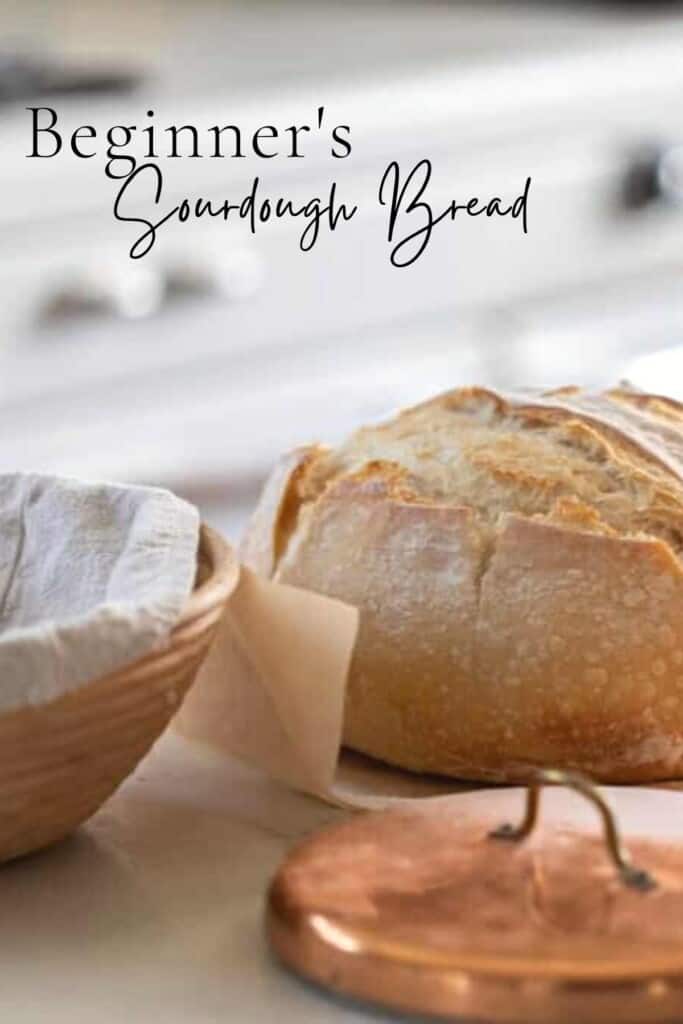
What is sourdough bread?
Sourdough bread is a fermented bread that uses natural wild yeast from the environment that has been captured to rise and ferment, rather than relying on commercial yeast.
Sourdough Health Benefits
As the grain is fermented, the gluten and phytic acid are broken down, making it easier to digest and more nutritious. Those who are sensitive to gluten (not celiac) may be able to tolerate sourdough products (especially long fermented), due to the fermentation of the grains.
Phytic acid (that is naturally present in wheat), is an anti-nutrient that blocks absorption of the nutrients found in wheat. During the fermentation, this gets broken down and the nutrients are more bio-available to the body.
Common Sourdough Terms:
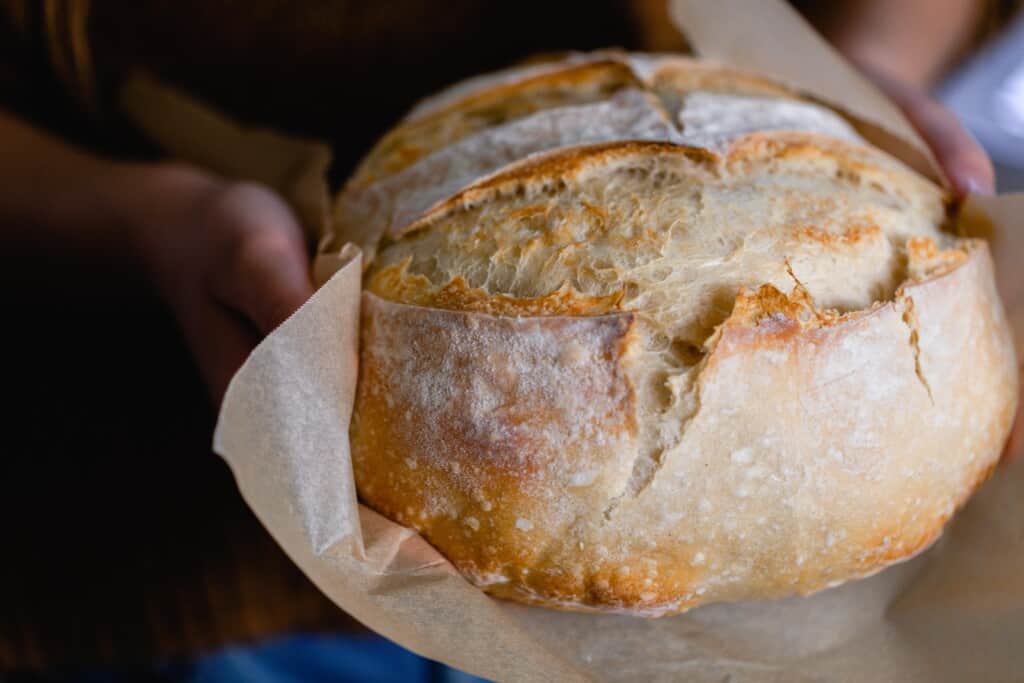
Sourdough Starter
A mixture of flour, water, wild yeasts, bacteria, and organic acids that is used to ferment and leaven breads and grains. You can easily create one from scratch, purchase one or get one from a friend to start your sourdough adventure.
Sourdough Discard
The amount of starter that is removed from the sourdough starter before feeding. You can toss it or use it for many wonderful sourdough discard recipes.
Technically, you never have to actually throw it away. You can use it in discard recipes, or, once your starter is mature enough, you can just keep feeding it and using it. Make sure you don’t get too much starter or else it will be hard to maintain and keep healthy (which is the reason most discard).
Fed Sourdough Starter Or Active Starter
This is a sourdough starter that has been fed 4-12 hours before starting the dough. It is active and bubbly. It should pass the float test when a small amount of starter is placed in a cup of water. If it floats, it is ready to use for bread.
Autolyse
The process of hydrating the flour with water and allowing it to rest for 15-60 minutes during the bread making process.
Bulk Fermentation Or Bulk Rise
The first period of time a recipe rises. It is a very important step in sourdough baking. Not allowing the dough to rise enough will leave you bread that doesn’t get a good rise in the oven. Bulk ferment too long and the dough will over ferment and become a wet soupy mess. Usually, the dough should be about double in size.
Score
Cutting a line or design on the top of the dough with a sharp utensil like a razor, lame, or knife to give bread a beautiful design. There are two kinds of scores: expansion score (a deep score that allows the bread to expand). Artistic scores: the pretty design that doesn’t have much function except to make beautiful bread.
Windowpane Test
Taking a small amount of dough, stretch it between your fingers into a square to see if it can stretch thin enough to be able to “see” through it without breaking. This is a good indicator that enough gluten formation has been created to capture a good rise and large holes in the crumb.
Proofing
The final rise for the dough before baking to leaven the dough.
This post contains affiliate links, which means I make a small commission at no extra cost to you. See my full disclosure here.
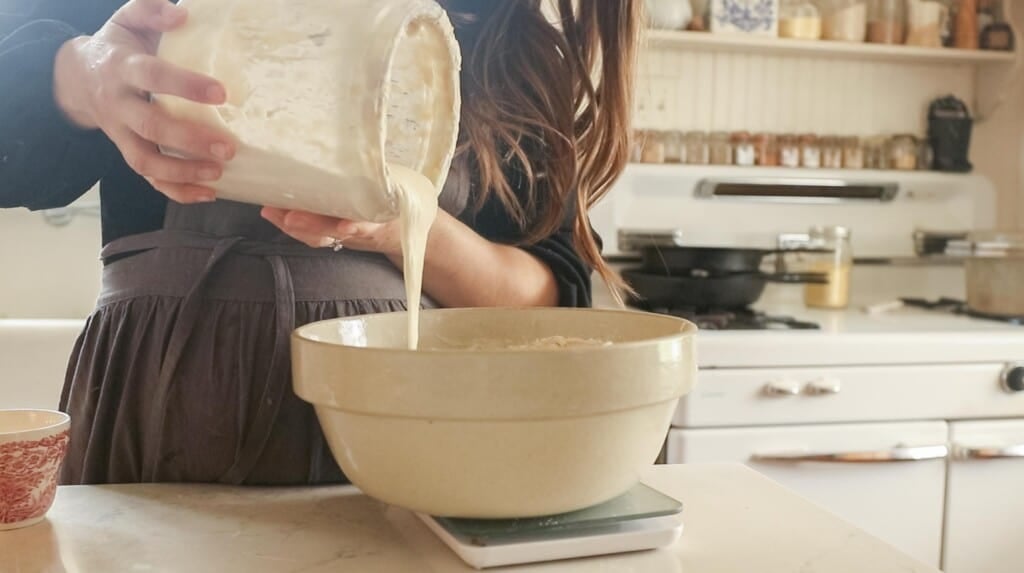
Tips:
- You will need a very active sourdough starter that passes the float test. Check out how to make your own sourdough starter and how to care for one here.
- The dough may seem dry when it is first coming together. Resist adding more water. Use wet hands during the stretching and folding if the dough is too sticky.
- The amount of time it takes for your dough to double can be determined by many environmental factors, such as the temperature in your home, the maturity of your starter, and the hydration status of the loaf.
- The most accurate way to create consistent results is by using a kitchen scale. I’ve included both gram measurements and cup measurements in the recipe.
Ingredients
All purpose flour – Since this is a beginners loaf I’m using something most people already have in their pantry, all-purpose flour. You could also substitute with bread flour.
Water
Active sourdough starter – This is a starter that has been fed 4-12 hours before starting the recipe, is active and bubbly, and has about doubled in size. Learn how to make your own starter here.
Salt
Tools you may need to make this recipe:
Kitchen scale or measuring cups and spoons: I prefer to weigh my bread to get the most accurate and consistent results.
Banneton (optional): You could also use a towel lined basket or bowl.
Dutch Oven: This gives the bread a really nice crispy crust. If you do not have a dutch oven you could bake it on a baking sheet. To get the crust you will need to create steam in the oven. You can spray the loaf with water, and add a baking dish of water to the bottom rack of your oven.
Parchment paper: You could also add cornmeal to the bottom of the dutch oven to help prevent sticking, but I’ve never had great luck with this and prefer the parchment paper method.
Lid or plastic wrap: A lid, plastic wrap, a large plate, or beeswax wraps can all work.
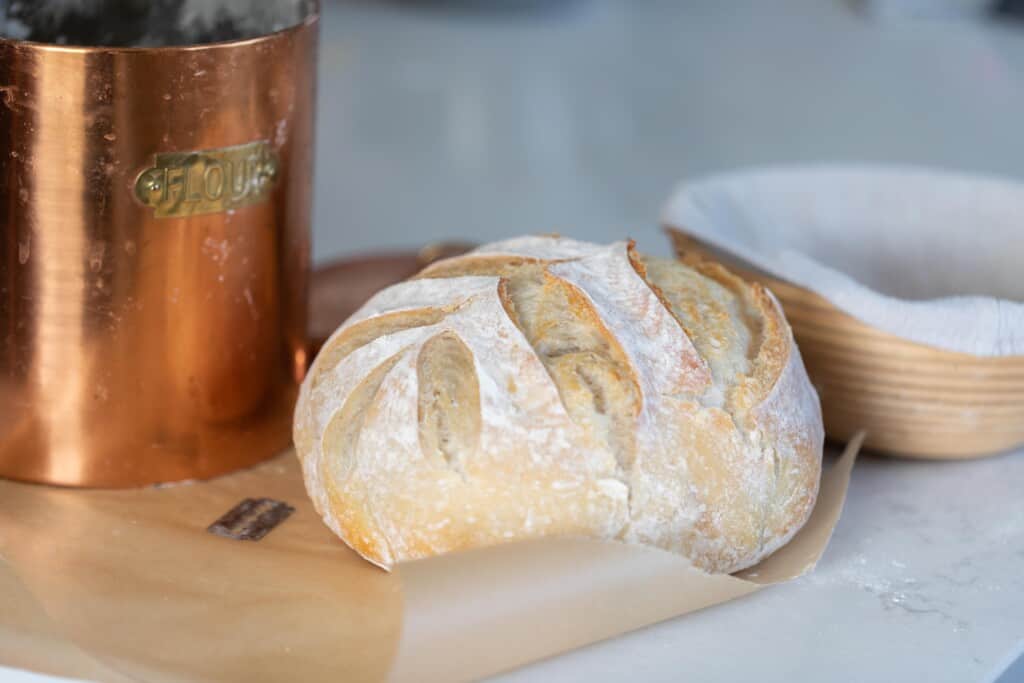
How To Make Beginner’s Sourdough Bread: Easy Step-By-Step Instructions
Feed a sourdough starter 4-12 hours before starting the dough, ensuring it is active and bubbly.
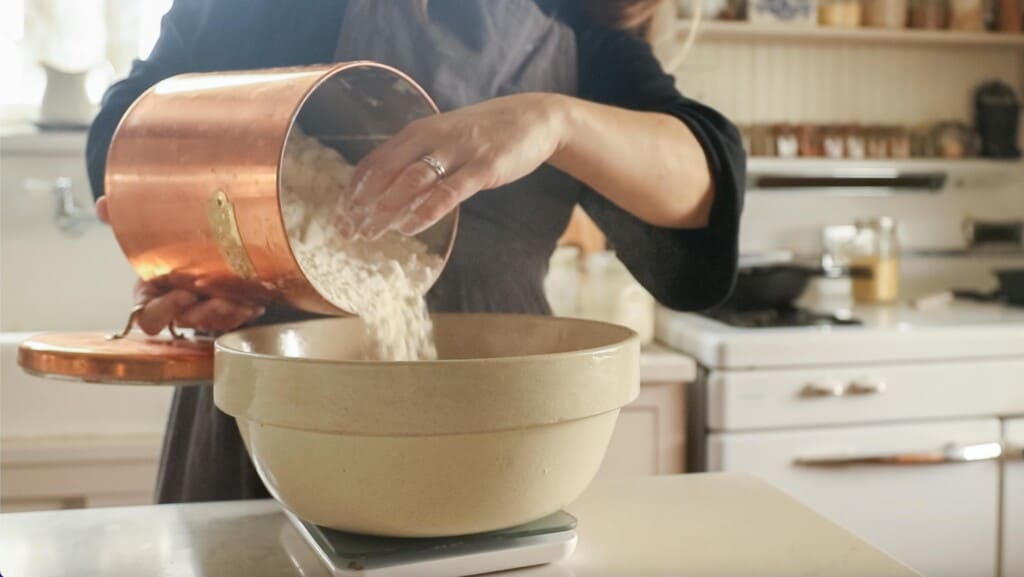
Add warm water, active starter, salt, and flour to a large mixing bowl. A kitchen scale will give the most accurate results.
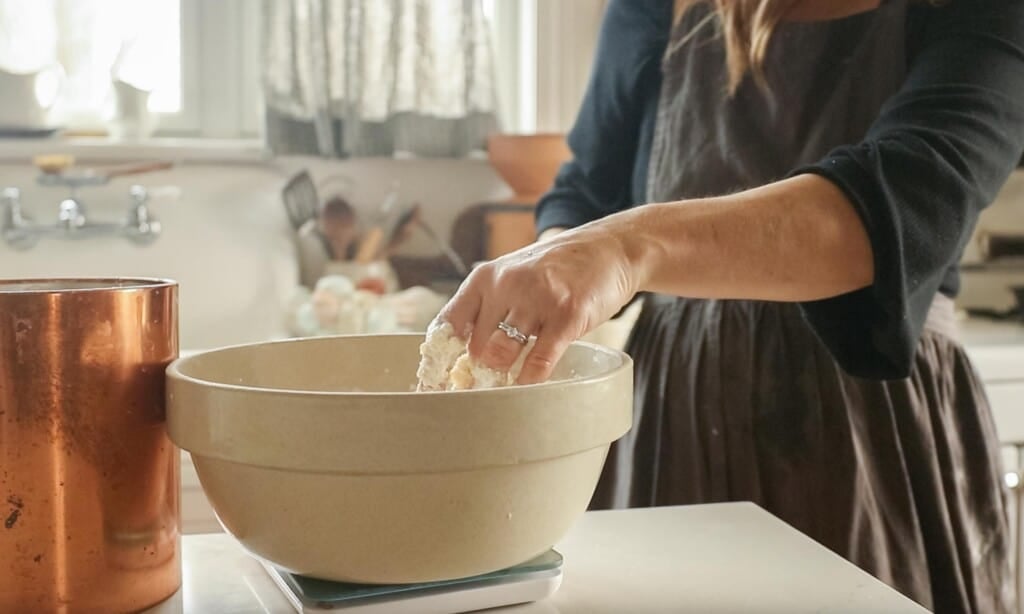
Mix together with wooden spoon or even just your hands.
Cover with plastic wrap or a lid and allow to rest for 30 minutes for the water to hydrate the flour. This is the autolyse process.
Stretch And Fold
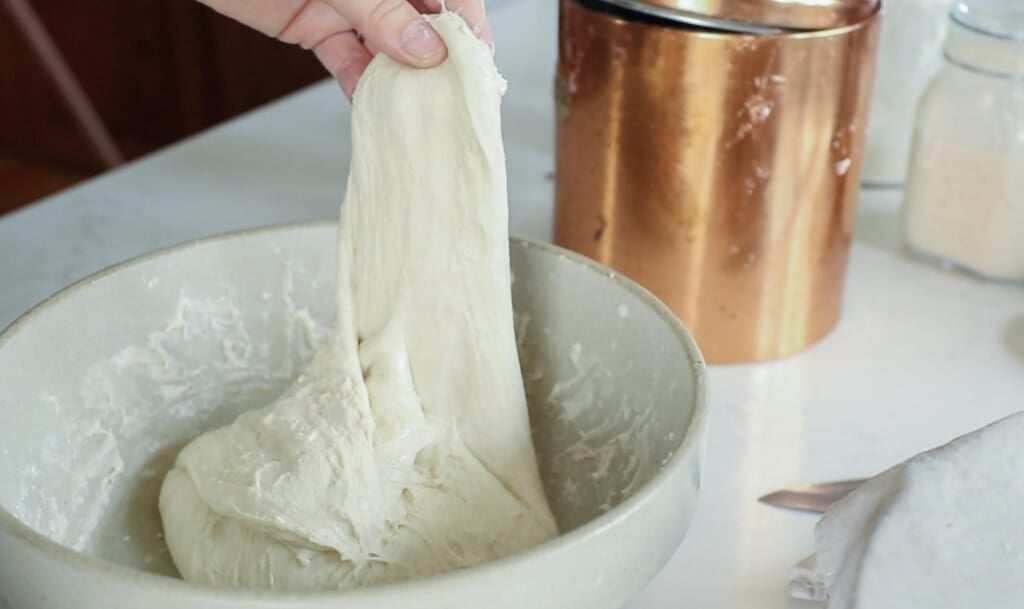
Rather than kneading the dough we are going to do a different method called the stretch and fold method. This is a way to get those desirable large holes in the crumb.
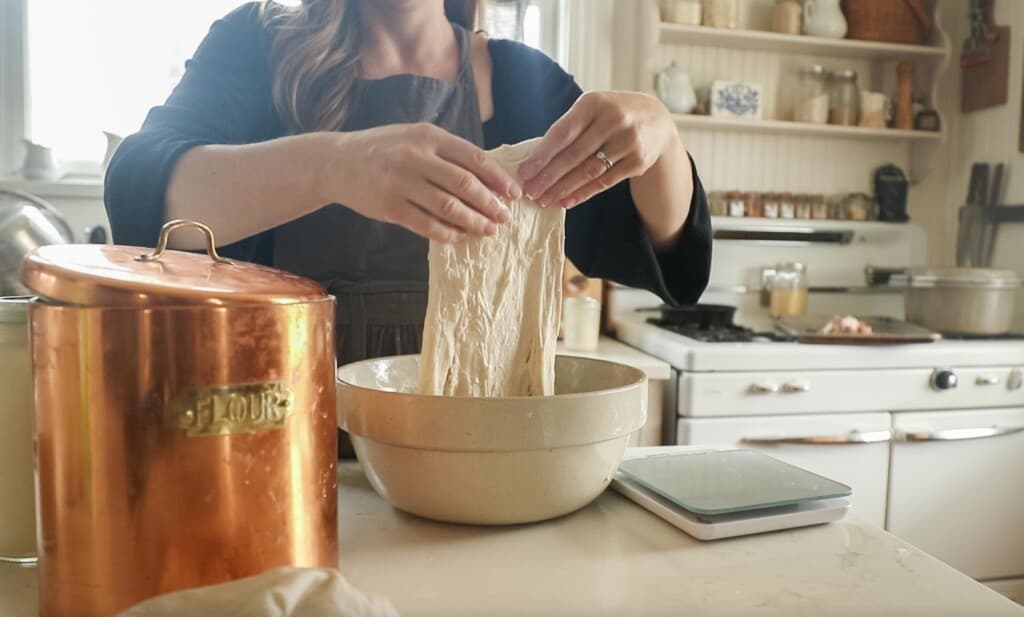
Grab the edge of the dough and pull up stretching it out as you pull upwards. This may be difficult and you may need to kind of bounce the dough to get it to stretch.
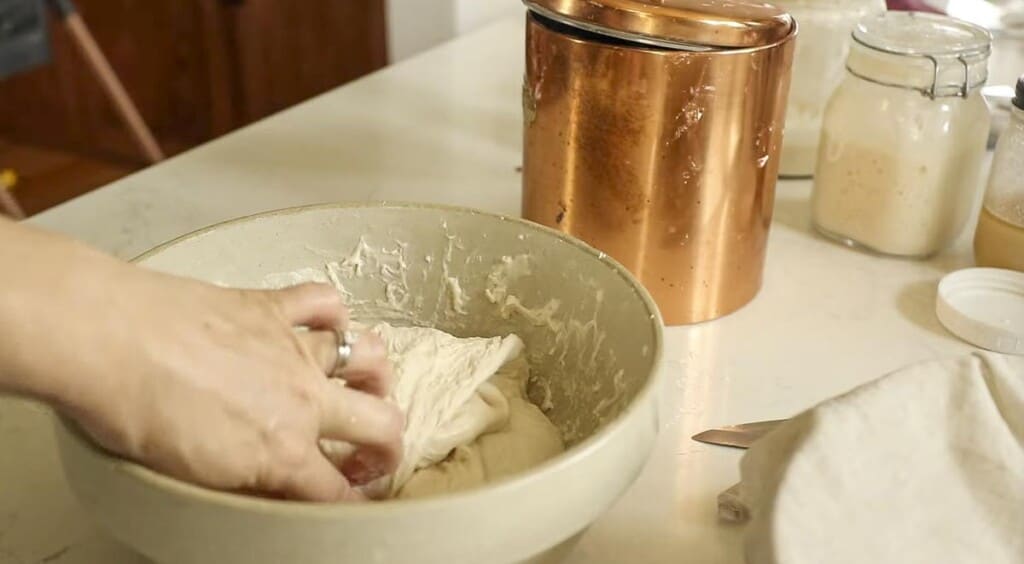
Place dough that is in your hands back into the center. Turn the bowl about a quarter turn and complete another stretch and fold. Repeat two more times. This is considered one round. If the dough is too sticky, dip your hand in warm water.
Cover and complete two more rounds 30 minutes apart.
Cover with a lid, damp towel, or plastic wrap. Let the dough bulk ferment in a warm place until it has doubled in size. This could be anywhere from 6-12 hours (or longer) depending on the temperature of your kitchen, maturity of your starter, etc.
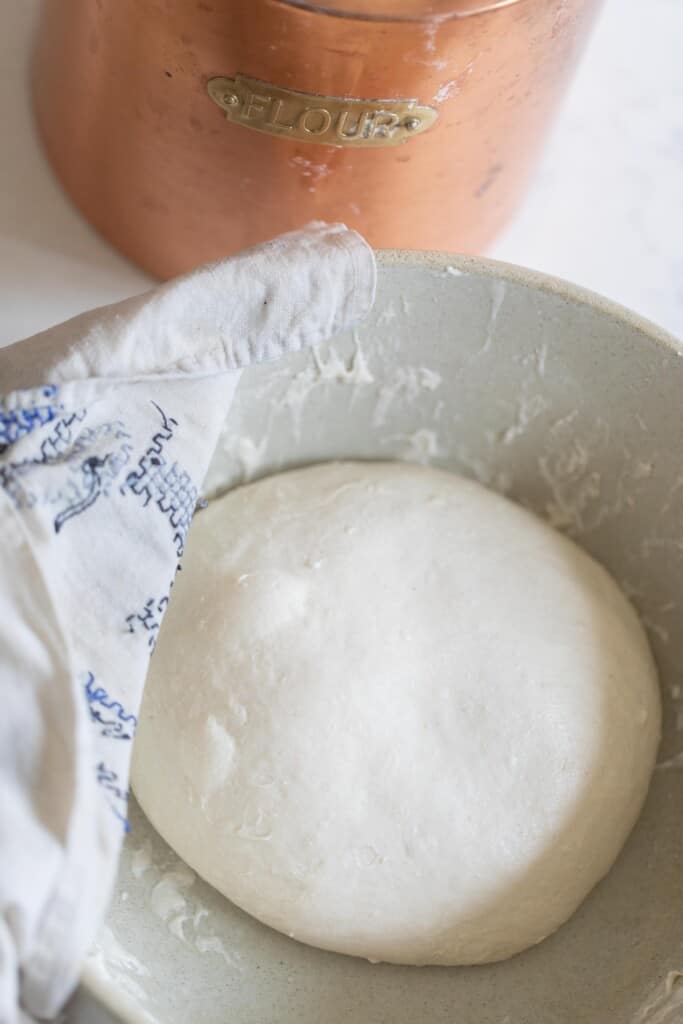
Be careful not to let it over ferment. If it is allowed to go too long, it will rise too much and become a soupy mess. It will not get a good rise when it bakes and resembles more of a pancake than a fluffy loaf. If this happens you can make stuffing, croutons, or bread pudding. It is not a total loss.
Shape
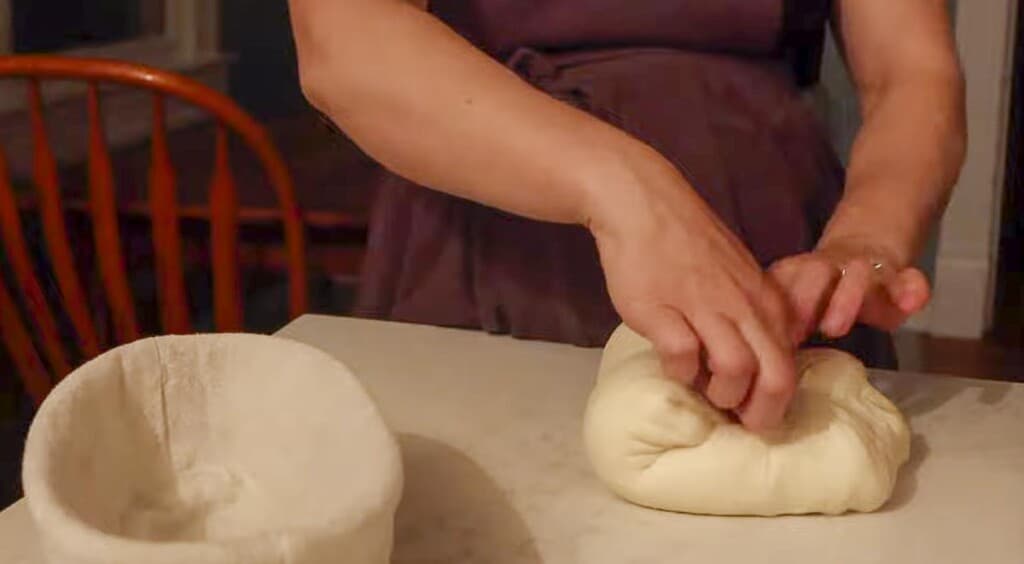
Place the dough on a clean work surface that has been lightly dusted with flour.
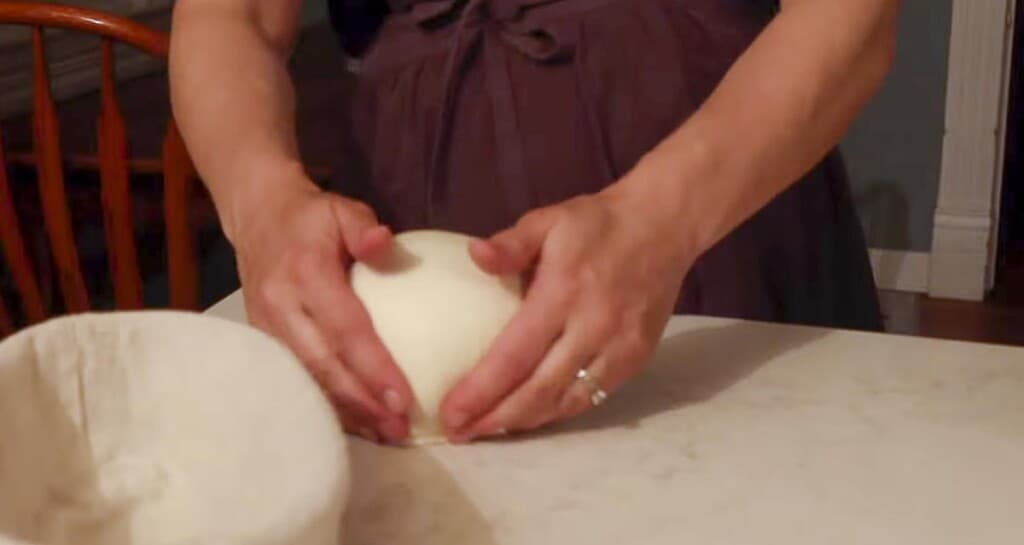
Fold the dough onto itself and roll up. Then shape into a ball by gently spinning it toward you.
(Optional)Set out 15-20 minutes uncovered. This allows the surface to develop a skin, so that it doesn’t stick to the tea towel during the overnight rise.
Then, place your dough upside down (smooth side down) on the counter and shape. I do this by folding the two sides over to meet in the middle, pinch together and then repeat on the other two sides. This creates surface tension which helps give it more oven spring (a good rise).
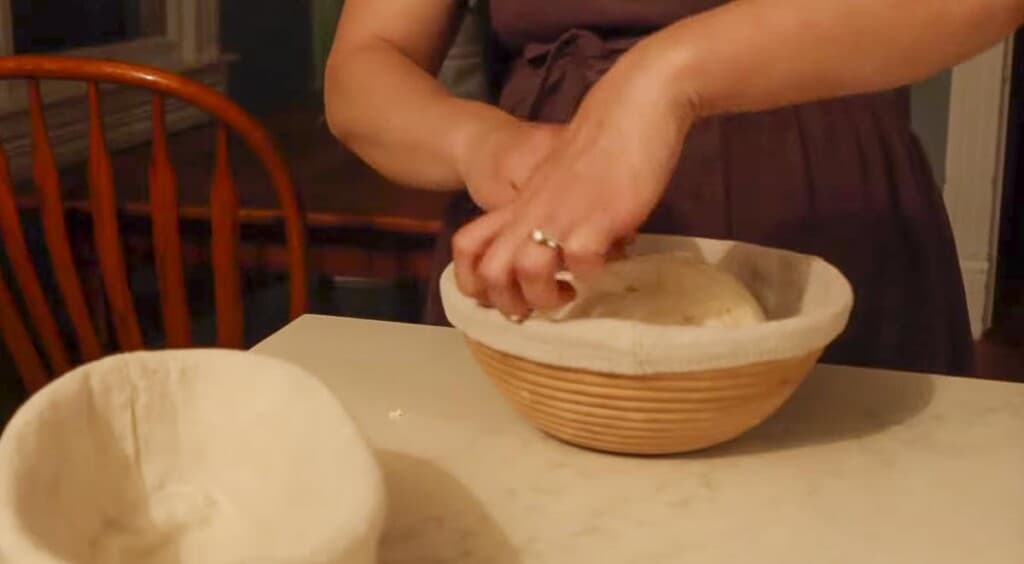
Transfer to a floured banneton or bowl with a floured tea towel (typically floured with rice flour, this is not necessary and all-purpose will work just fine) seam side up. You want the smooth side or pretty side facing down in the banneton. (Remember, the crust was so it wouldn’t stick to the tea towel!)
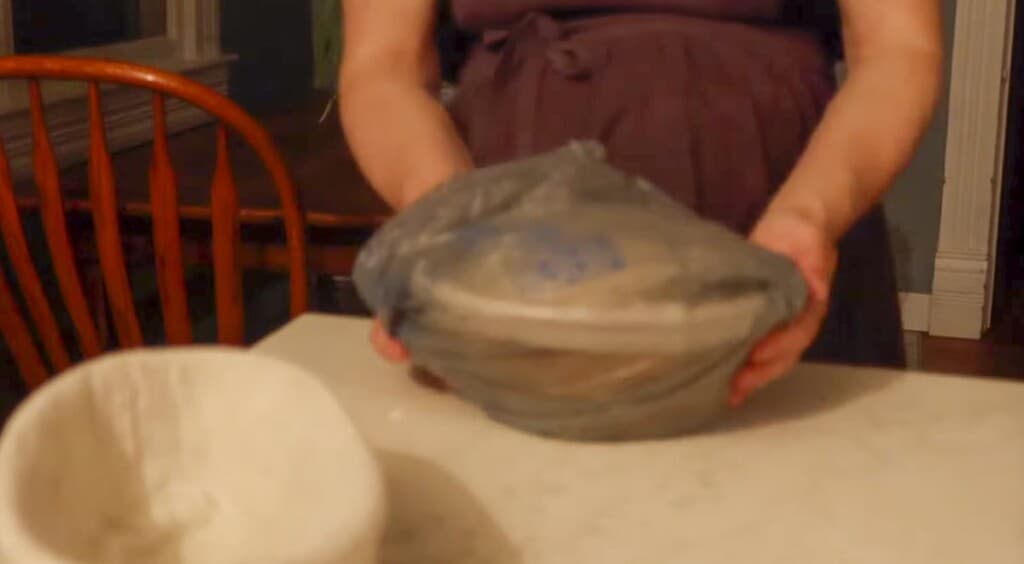
Cover with plastic or place in a plastic bag and tie the ends. Let the dough rest for 12-15 hours in the refrigerator. You can also let the bread rise at room temperature for 3-4 hours. I like using the longer rise time in the refrigerator because it is easier to score and I feel like the oven spring is better.
Bake
Preheat a dutch oven to 500 degrees for 1 hour.
Remove dough from the fridge right before baking.
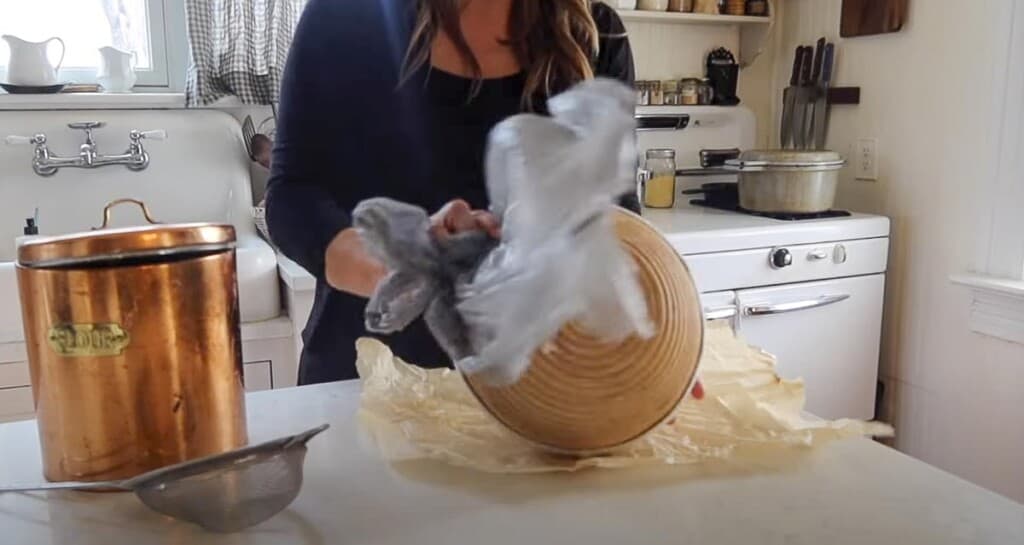
Place dough on a piece of parchment paper.
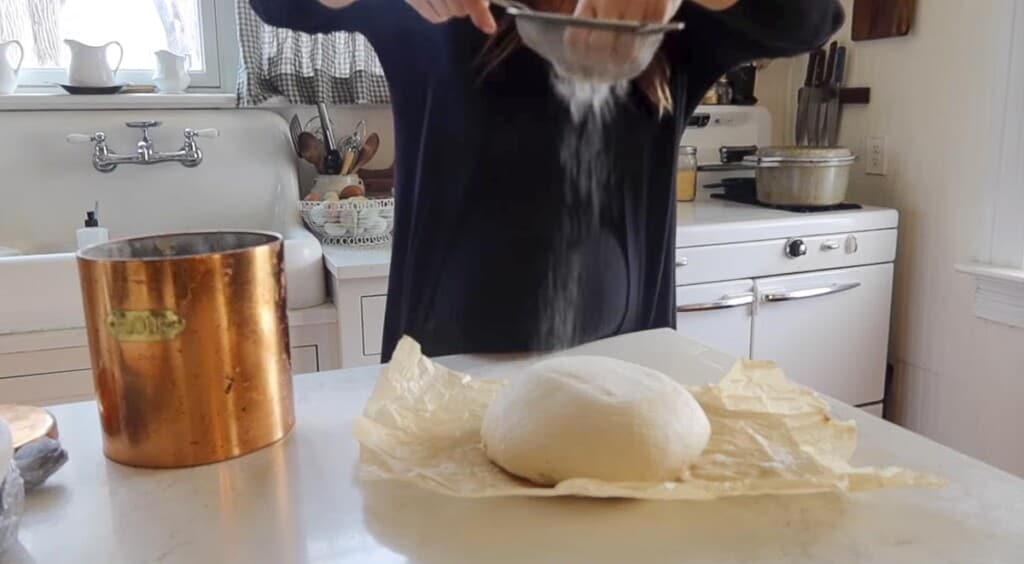
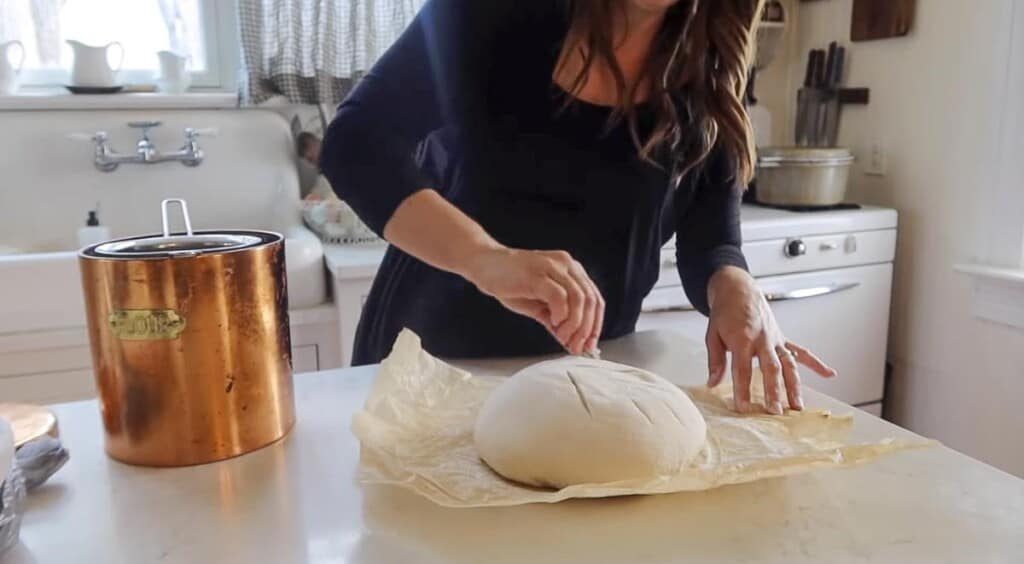
Dust with flour, if desired, and score with lame or razor blade. I like to do one large score (called an expansion score) and then a cute design for the other score.
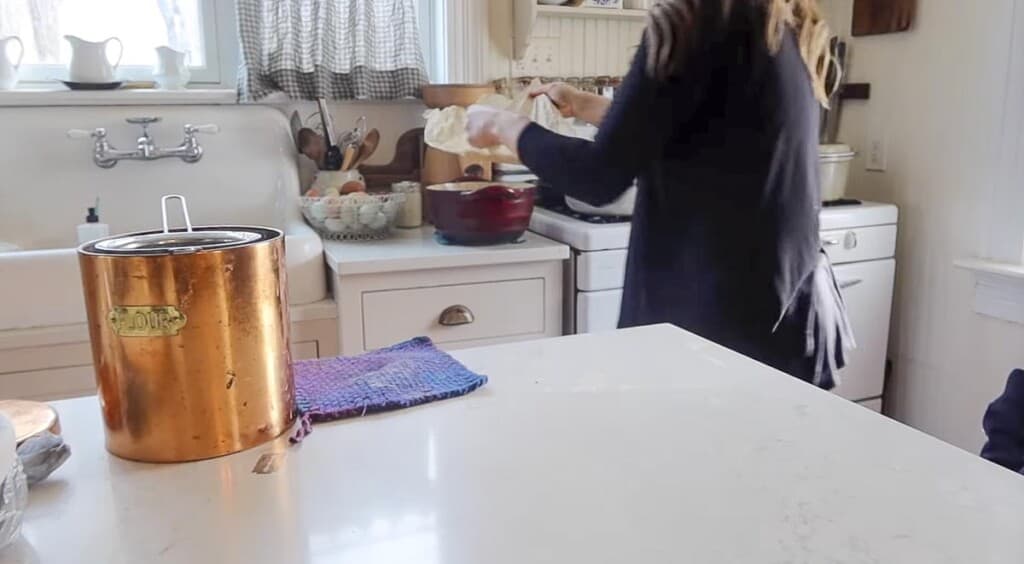
Carefully, transfer the piece of parchment paper with the dough into the hot dutch oven. Careful not to burn your fingers.
Place the lid back on and place the dutch oven into the hot oven. Bake for 20 minutes.
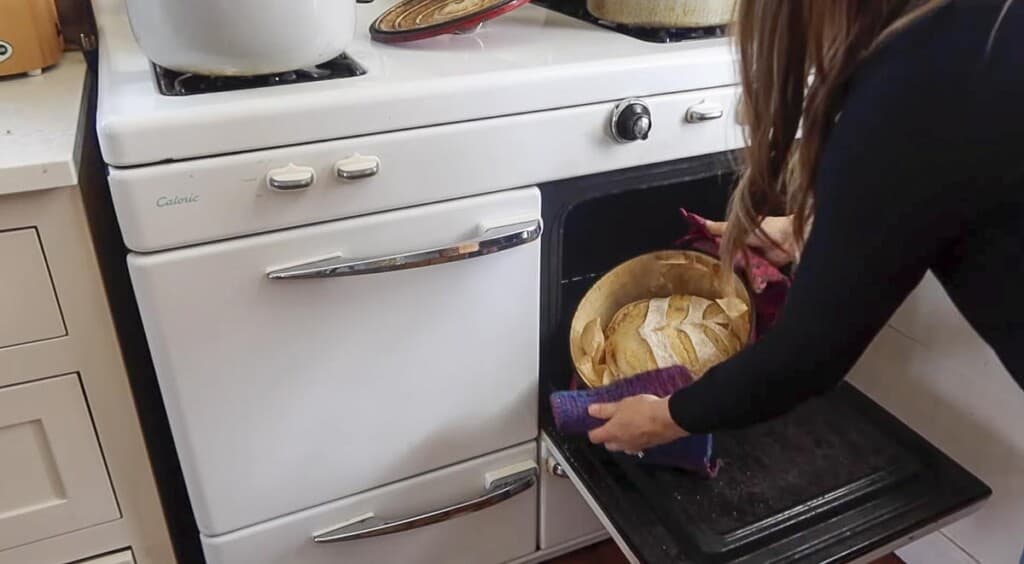
Carefully remove the lid with oven mitts, turn the oven temperature down to 475, and bake an additional 15-25 minutes or until golden brown.
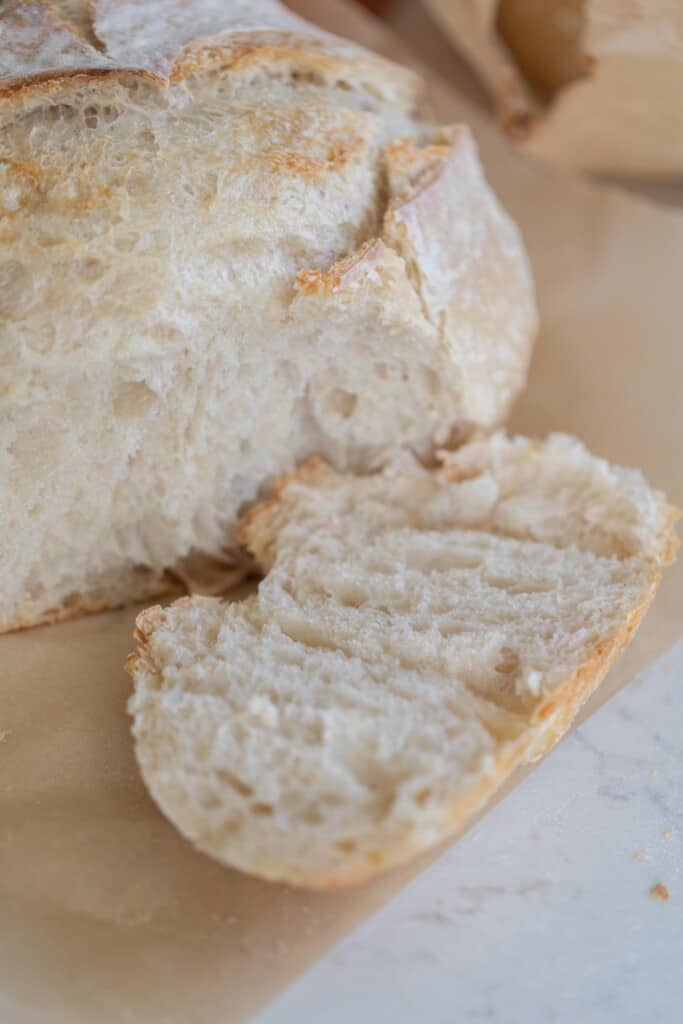
Best Tips For Scoring
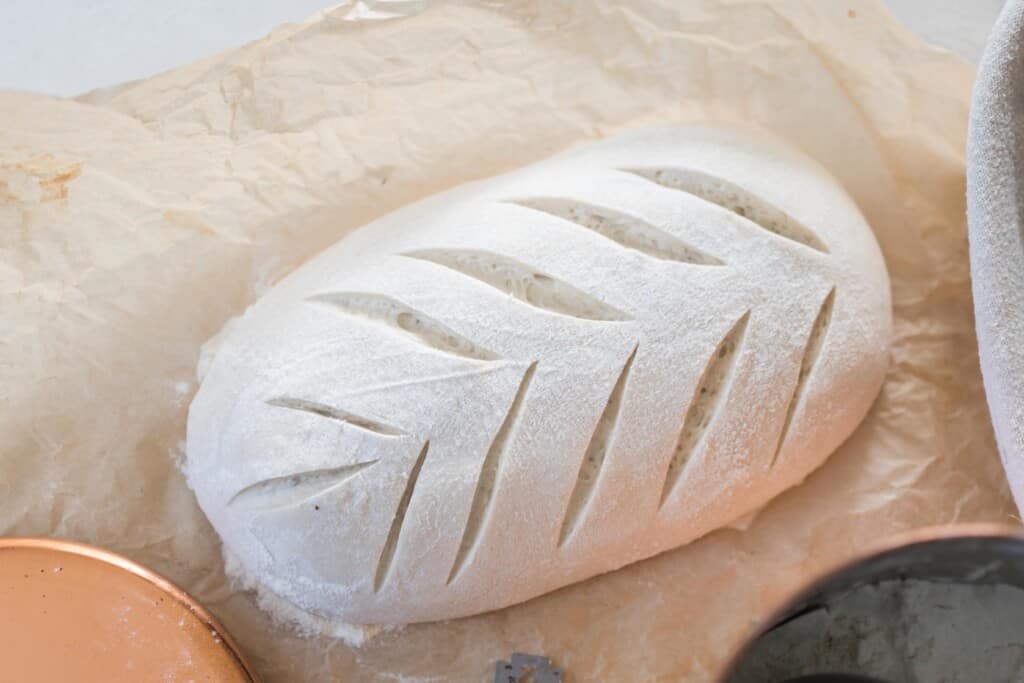
- I highly recommend the long fermentation in the fridge. Yes it takes a long time, but this is the best way to make the dough more firm making the scoring easier and prettier.
- To make the pattern stand out more, dust the top of the dough with a bit of flour.
- Use a razor. A knife will just not have the same results.
- Find pretty patterns online to try to replicate. I have a post on my go-to patterns here.
- Practice. It takes a lot of trial and error to figure out bread baking in general and how to create pretty designs, the right depth to cut, etc.
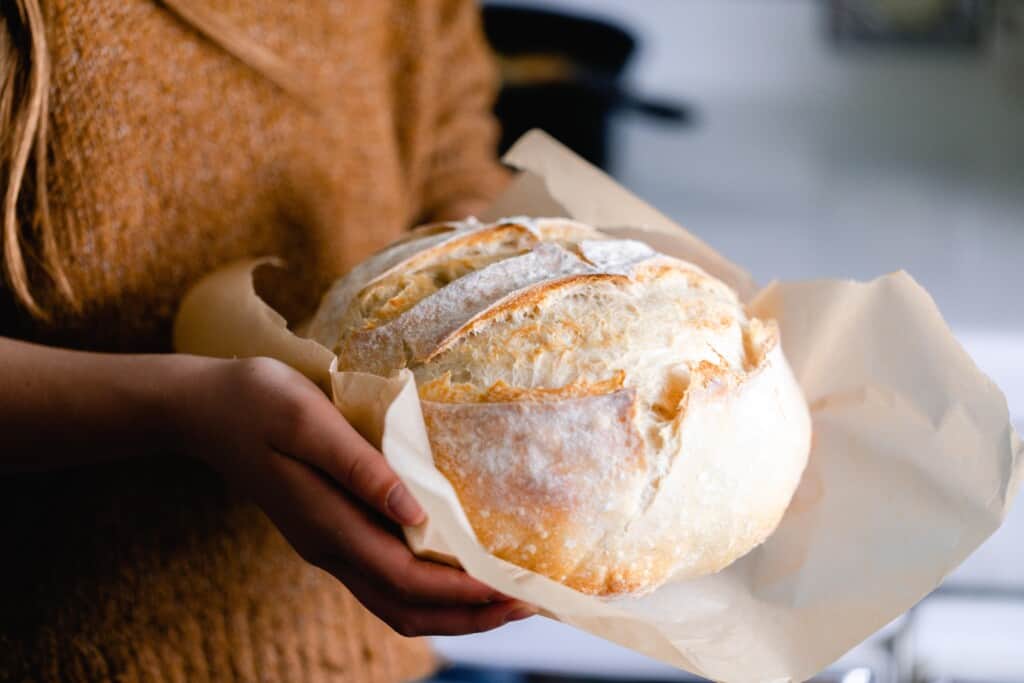
Bakers Timeline For No-Knead Sourdough Bread
9 pm: Feed sourdough starter with flour and water.
8 am the next day: If the sourdough starter is mature, then proceed to creating the dough.
Combine ingredients together. Rest for 30 minutes.
Cover with a damp towel or plastic wrap. Rest for 30 minutes.
8:30 am: Stretch and fold.
3 stretch and folds – every 30 minutes
Cover with a wet towel or plastic wrap and allow the dough to bulk ferment until doubled.
Anywhere from 4:00 pm to 10 pm: Shape dough.
Sit out 15-20 minutes, uncovered.
Turn over and shape.
Transfer to a floured banneton basket or bowl with tea towel and cover with plastic. Place in the refrigerator for 12-15 hours.
The Next Day
9:00 am: Preheat the dutch oven on 500 for 1 hour.
10:00 am: Take dough out of the fridge, dust with flour, and score. Bake the sourdough bread and let it cool.
FAQ:
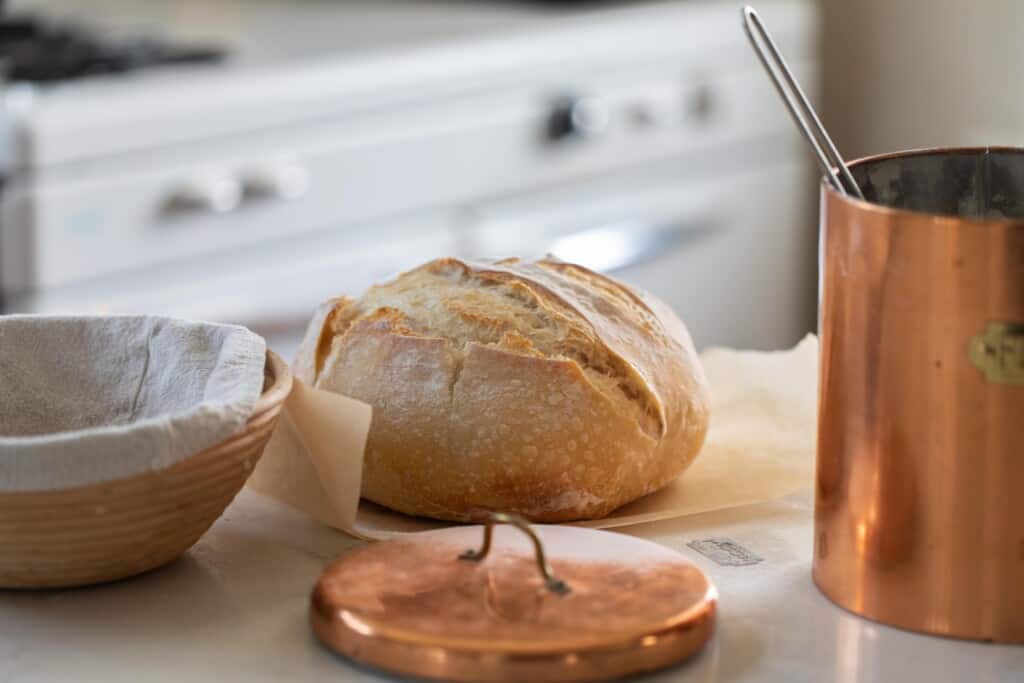
How do you make a sourdough starter?
Creating a sourdough starter is actually pretty simple. It is the process of mixing water and flour together and discarding for multiple days until yeasts in the environment are captured and the flour bubbles. You can find the tutorial on how to make a sourdough starter here.
Is it necessary to knead sourdough?
Not necessarily. The act of kneading is supposed to help create gluten formation in the bread, which can then help create a good texture and air pockets in the bread. But no-knead sourdough bread uses a stretch and fold method to develop the gluten.
What flour is best for beginner sourdough?
All-purpose flour or bread flour are perfect for the beginner baking just getting into sourdough. These flours can be used to feed the starter and bake with.
What are three top tips when making sourdough starter?
- Give it time. It takes a while for a sourdough starter to mature enough to make bread. Eventually it will happen and it is totally worth it.
- Don’t give up. Even if it doesn’t look like there is a lot of activity going on, there is.
- It probably isn’t dead. Many times people come to me asking if their sourdough starter is dead because it has a black liquid on top, a hard crust, etc. But unless there is mold, it can probably be revived.
What do I need to start making sourdough?
There are a few baking essential that you will need to start:
Large bowl- one with a lid is even better
Measuring cups and spoons or a digital scale. Scales are more reliable and will give you more consistent results.
Dutch oven and/or loaf pans
Other tools that are optional, but helpful:
Banneton baskets or a proofing basket (can also use baskets or bowls lined with a tea towel)
Lame
Dough whisk
What is the secret to a good sourdough starter?
The secret to a good starter is to use it when it is active and bubbly, and at its peak. You can tell this by how it looks: has it about doubled in size, have nice bubbles, and does it float when a small amount is placed in a glass of water?
Why is sourdough difficult to make?
Sourdough is not really that difficult to make, it just takes longer and has more variability compared to bread made with commercial yeast. While a dough made with active dry yeasts typically rise 1 1/2 to two hours during the bulk rise. A simple sourdough bread may take 8-12 hours.
Find More Sourdough Bread Recipes:
- Bread Machine Sourdough Bread
- Cheese Jalapeño Sourdough Bread
- Sourdough Potato Bread
- Rosemary Sourdough Bread
- Sourdough Sandwich Bread
If you try this recipe and love it, I would love it if you gave it 5 stars! Thank you! Tag me on Instagram @farmhouseonboone.
Beginners Sourdough Bread
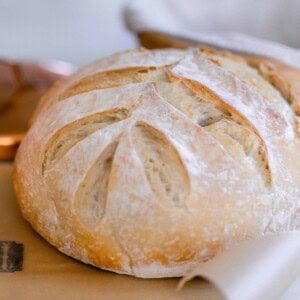
Ingredients
- 475 grams all-purpose flour, 3 1/2 cups
- 100 grams starter, active and bubbly (1/2 cup)
- 325 grams water, 1 1/3 cups
- 10 grams salt, 2 teaspoons
Instructions
- Feed a sourdough starter 4-12 hours before starting the dough, ensuring it is active and bubbly.
- Combine warm water, active starter, salt, and flour with a wooden spoon or even just your hands in a large mixing bowl.
- Cover with plastic wrap or a lid and allow to rest for 30 minutes for the water to hydrate the flour.
Stretch And Fold
- Grab the edge of the dough and pull up stretching it out as you pull upwards. This may be difficult and you may need to kind of bounce the dough to get it to stretch. Place dough that is in your hands back into the center. Turn the bowl about a quarter turn and complete another stretch and fold. Repeat two more times. This is considered one round.
- Thirty minutes later, complete another round of stretch and folds. Cover and allow the dough to rest another 30 minutes.
- Complete one last stretch and fold round.
- Cover with a lid, damp towel, or plastic wrap. Let the dough bulk ferment in a warm place until it has doubled in size. This could be anywhere from 6-12 hours (or longer) depending on the temperature of your kitchen, maturity of your starter, etc. Be careful not to let it over ferment.
Shape
- Place the dough on a clean work surface that has been lightly dusted with flour. Fold the dough onto itself and roll up. Then shape into a ball by gently spinning it toward you.
- Optional – Let the dough sit out for 15-20 minutes uncovered. This prevents the dough from sticking to the tea towel during the overnight rise.
- Turn over and shape. I do this by folding the two sides over to meet in the middle, pinch together and then repeat on the other two sides. This creates surface tension which helps give it more oven spring (a good rise).
- Transfer to a floured banneton or bowl with a floured tea towel (typically floured with rice flour, this is not necessary and all-purpose will work just fine) seam side up.
- Cover with plastic or place in a plastic bag and tie the ends. Let the dough rest for 12-15 hours in the refrigerator. You can also let the bread rise at room temperature for 3-4 hours. I like using the longer rise time in the refrigerator because it is easier to score and feel like the oven spring is better.
Bake
- Preheat a dutch oven to 500 degrees for 1 hour.
- Remove dough from the fridge right before baking. Place dough on a piece of parchment paper.
- Dust with flour, if desired, and score with lame or razor blade. I like to do one large score (called an expansion score) and then a cute design for the other score.
- Carefully, transfer the piece of parchment paper with the dough into the hot dutch oven. Careful not to burn your fingers.
- Place the lid back on and place the dutch oven into the hot oven. Bake for 20 minutes.
- Remove the lid with oven mitts, turn the oven temperature down to 475, and bake an additional 15-25 minutes or until golden brown.
Notes
- You will need a very active sourdough starter that passes the float test. Check out how to make your own sourdough starter and how to care for one here.
- The dough may seem dry when it is first coming together. Resist adding more water. Use wet hands during the stretching and folding if the dough is too sticky.
- The amount of time it takes for your dough to double can be determined by many environmental factors, such as the temperature in your home, the maturity of your starter, and the hydration status of the loaf.
- The most accurate way to create consistent results is by using a kitchen scale. I've included both gram measurements and cup measurements in the recipe.
Nutrition
Nutrition information is automatically calculated, so should only be used as an approximation.



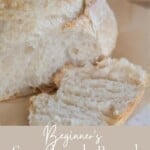










Hello! I love all of your recipes and make them quite often!
A few questions for this sourdough loaf:
1. What kind of flour are you mulling for this?
2. Can I split the dough to make 2 smaller loaves? If so, when would I do that?
Thank you! I used just regular all-purpose flour from the store. You could, the baking time would need to be adjusted. Let it bulk rise, then split them during shaping.
Do any adjustments need to be made to this recipe when using freshly milled flour? Thanks!
Freshly milled can make things more dense on no knead bread. To make it fluffy, I recommend adding a bit of honey and oil like in my 100% whole wheat loaf.
This recipe is pure perfection! It was the best one that I’ve tried so far, and my loaf came out stunningly beautiful, crunchy, and filled with holes
So glad you enjoyed it! thanks for sharing!
I kept at it, finally got a perfect loaf! My starter just needed some age on it. Thank you for your clear step by step instructions! We have been enjoying the discard crackers wow so delish. Will be making this bread several times a week. Thank you for all your recipes and ideas!
Yay! That is so great to hear!
The best article on sourdough.
Thank you so much!
My first ever sourdough bread, after 2 weeks of getting my starter ready. What an experience. I was nervous because of reading so many complicated sounding recipes, even though I’ve had a lot of success baking. I found your recipe, and this loaf turned out amazing. Thanks! I will be making it again.
So glad to hear this!! Thanks for sharing!
Wow. WOW. I am in LOVE with my sourdough!! I’ve spent the last month making crazy tough and flat and tasteless little loaves based on another recipe I was given. Finally I decided I HAD to figure out what was going wrong, so I found your recipe and decided to give it a go. Your recipe calls for a little less water and flour, and double the amount of the starter than my old recipe used, and called for a much longer countertop prove time, and a hotter oven for a shorter overall bake time. These changes resulted in a beautifully aerated and risen loaf, deliciously chewy on the inside and crunchy (but not overly so) on the outside. The flavor was so much more sour too, which was wonderful. At last,I have a loaf that I’m proud to serve to my family, AND to share with my friends! Thank you so much for sharing your wonderful recipe and tips. You’re a loaf-saver!
That is amazing!!! Wow. Thank you for sharing, and I’m so glad you enjoyed the recipe.
I ended up putting too much water in the recipe. Is there anything I can do to save the dough? I don’t want to throw it away. I put in 375gm of water instead of 325. Sigh!
You could try to add more flour! Sorry. That is such a bummer.
For the future, that’s not a problem at all, just do stretch and folds every 15 minutes. The dough will hold its shape better and better with each s&f, do those till the dough is strong
I just had the same issue, I accidentally put too much water and also used bread flour instead of all purpose. It was soupy and sticky the entire process. I ended up adding a ton of extra flour to counter it, did lots of kneading and stretching. I thought for sure I should throw it away when I took it out of the fridge this morning, as it was a flat floppy mess. But I had already preheated the oven so figured might as well finish. I’m so glad I did! It baked beautifully! Definitely a trust the process moment. I will definitely try this recipe again, but hopefully following directions a little better. 🙂
Wow what a turn around . I love when things go right just by chance, that’s my kitchen on a daily basis 😆 congrats
Sadly I never got a rise out of my bread. Left on the counter for 15 hrs (~73 degrees) it was bubbly and very wet. I’m the morning I could hardly handle it, but went ahead and shaped and put into basket and left on the counter for 4 hrs. Size still didn’t change. I was hoping it would get a rise when baking but it didn’t. It’s just very flat. Could it be my starter? It passed the float test but it is a young starter.
This is my 4th attempt with the same results (first time using your recipe) Any advice would be really appreciated!
It was bubbly and very wet when you started the bulk ferment or after? If it was after, it is possible it was over fermented. It will turn into a wet sloppy mess if left to ferment too long. Rising issues could be from an immature starter as well.
great overview, Lisa!
From the description of just reading the recipe this is a two day Process?. Will try,but a good overnight rise in the fridge and a 2 to 4 rise on the counter should be Sufficient( depending on temp.) Will let you know. Just keep dough moist, must have a strong starter.
She does actually say, “or leave it for 4 hours on the counter” as an alternative for the long ferment in the fridge. Remember she’s making sourdough bread along with raising babies… something us mums know can be difficult to time right. I love that Lisa gives 2 options for the second rise it helps me fit baking around being a busy mummy. If you review other recipies you’ll see she often does this… I love her for it. Cheers lisa- another cracking sourdough loaf for me!
The reason for overnight is to do the fermenting. If you don’t want sourdough then don’t do it that way and just do regular bread. There is a reason for it all. The more it rest, the more it ferments and the better it’ll taste. Not to mention getting rid of gluten.
Lisa has done tons of research and tons of real life application to find the best food possible.
If sourdough isn’t for you, that’s fine. But please, the prices is for a reason. If you go watch her YouTube video on this you would learn exactly why.
Thank you! I really need this! I have had my sourdough starter since last summer and can make all things except a basic loaf of sourdough bread. I’ve been making freshly ground bread for years yet this is so different. I’ll be doing this tomorrow!
I hope it turns out great!
Can I mix another kind of flour with all-purpose?